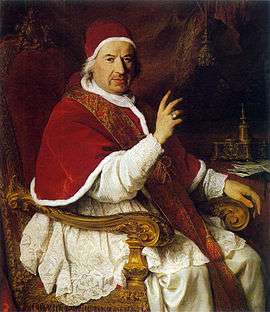Postremo mense

Pope Benedict XIV promulgated the papal bull Postremo mense on 28 February 1747. Like all such documents, it takes its name from the opening words of its Latin text, Postremo mense superioris anni meaning "In the last month of the previous year". The bull summarised and restated certain aspects of Catholic Church teaching on infant baptism.
Description
Benedict set out several guidelines:[1][2]
- it is generally not licit to baptize the child of a Jewish family without parental consent
- it is licit to baptize a Jewish child in danger of death without parental consent
- church authorities have a duty to remove a baptized child from its parents' custody if the parents have not been baptized and to provide the child with a Christian education, whether that child's baptism is licit or not
Ecclesiastical authorities severely punished those who conducted illicit baptisms, but the fact that a baptism was illicit had no effect on the consequences of the baptism for church policy. Before this papal bull, Catholic theologians - including Thomas Aquinas, Duns Scotus, Guillaume Durand and Francisco Suárez - had expressed differing opinions on these questions.[3][4]
Postremo mense was addressed to Ferdinando Maria de' Rossi, the vicegerent of the Diocese of Rome. In 1747, a Catholic named Antonio Viviani had entered the Ghetto of Rome, to which the Jews of Rome were confined, and baptized the three daughters, the eldest of whom was nine, of Perla Misani. Having run out of holy water, he repeated the words of baptism over their 12-year-old brother while their mother was absent. De' Rossi noted five similar such cases that had occurred recently and sought guidance from Benedict, who observed that "every time this occurs, it is talked about as if it were the first time this has ever happened".[5][6][7] Benedict directed that the baptized children be removed from the custody of their Jewish parents unless the parents were willing to embrace Catholicism. Were the children to revert to Judaism they faced punishment as apostates. Benedict rejected the compromise position that baptized children be allowed to remain with their parents under precisely defined conditions.[4] He also determined that Jewish children aged seven or older who requested baptism could be licitly baptized and removed from their parents' custody.[8]
On 15 December 1751 Benedict issued Probe te meminisse, which discussed related questions and laid down punishments for Jewish converts who abandoned Catholicism after being baptized.[9]
The practice of removing children who had been baptized from their Jewish parents continued until the fall of the Papal States in 1870. In 1858, Pope Pius IX cited Postremo mense when defending the church authorities who removed Edgardo Mortara from the custody of his Jewish parents on the grounds that the child had been baptized by a Christian servant and by law could only be raised in a Catholic household.[10][11]
See also
- Jewish orphans controversy (1946)
Notes
- ↑ Cunningham, James J. (2006). Summa Theologiae: Volume 57, Baptism and Confirmation: 3a. 66-72. Cambridge University Press. p. 112. ISBN 9780521029650.
- ↑ Carlen, Claudia (1990). Papal Pronouncements, a Guide, 1740-1978: Benedict XIV to Paul VI. Pierian Press. p. 6. ISBN 9780876502730. Retrieved 13 January 2018.
- ↑ Caffiero, Marina (2012). Forced Baptisms: Histories of Jews, Christians, and Converts in Papal Rome. University of California Press. p. 46. ISBN 9780520254510.
- 1 2 Caffiero, Marina (2012). Forced Baptisms: Histories of Jews, Christians, and Converts in Papal Rome. University of California Press. p. 56. ISBN 9780520254510.
- ↑ Kertzer, David I. (2008). The Kidnapping of Edgardo Mortara. Knopf Doubleday Publishing Group. p. 60. ISBN 9780307486714.
- ↑ Vogelstein, Hermann; Rieger, Paul (1895). Geschichte der Juden in Rom: Bd. 1420-1870 (in German). Mayer & Müller. p. 242.
- ↑ Caffiero, Marina (2012). Forced Baptisms: Histories of Jews, Christians, and Converts in Papal Rome. University of California Press. p. 148. ISBN 9780520254510.
- ↑ Denzinger, Heinrich; Church, Catholic (1957). The sources of Catholic dogma. Herder. p. 363.
- ↑ Michael, R. (2008). A History of Catholic Antisemitism: The Dark Side of the Church. Springer. p. 93. ISBN 9780230611177.
- ↑ Mattei, Roberto De (2004). Pius IX. Gracewing Publishing. pp. 155–156. ISBN 9780852446058.
- ↑ Jodock, Darrell (2000). Catholicism Contending with Modernity: Roman Catholic Modernism and Anti-Modernism in Historical Context. Cambridge University Press. p. 41. ISBN 9780521770712.